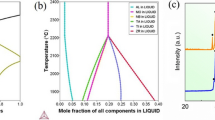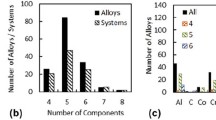Abstract
Pulsed electric treatment (PET) is a promising method for improving properties due to its clean, efficient, convenient, eco-friendly, and sustainable characteristics, thereby satisfying the target of carbon emission reduction and high-quality production. Previous studies have mainly focused on precipitate phases. In contrast, we place a primary emphasis on exploring the microstructural aspects to elucidate the reasons behind the performance enhancement of CuCrZr through PET. In this work, the properties and microstructure after PET in the cold-rolling CuCrZr alloy plate were investigated, and the mechanisms of PET were also revealed. The strength, strain, and electrical conductivity of CuCrZr alloy are increased by ~ 19.5%, ~ 186%, and ~ 73.1%, respectively. The improvement of the above properties is due to PET which can tailor the distribution of dislocation, achieve grain refinement, and promote the transformation of different textures. It is worth noting that dislocations move from the interior to around the grain boundary and gradually annihilate at high temperature with the increasing voltage of PET. At the same time, the current can enhance the < 111 > and < 101 > orientations and increase the volume fraction of {112} < 011 > texture and {112} < 110 > texture. Compared with traditional heat treatment, properties can be better improved under the proper processing parameters of PET. And the PET can induce the CuCrZr alloy to recrystallize at a low temperature.













Similar content being viewed by others
Data availability
The data that support the findings of this study are available in this paper and on a request from the corresponding author.
References
Lu L, Shen Y, Chen X et al (2004) Ultrahigh strength and high electrical conductivity in copper. Science 304:422–426. https://doi.org/10.1126/science.1092905
Zhao Z, Zhang Y, Tian B et al (2019) Co effects on Cu–Ni–Si alloys microstructure and physical properties. J Alloy Compd 797:1327–1337. https://doi.org/10.1016/j.jallcom.2019.05.135
Morozova A, Mishnev R, Belyakov A, Kaibyshev R (2018) Microstructure and properties of fine grained CuCrZr alloys after termo-mechanical treatments. Rev Adv Mater Sci 54:56–92. https://doi.org/10.1515/rams-2018-0020
Yang H, Ma Z, Lei C et al (2020) High strength and high conductivity Cu alloys: a review. Sci China Technol Sci 63:2505–2517. https://doi.org/10.1007/s11431-020-1633-8
Wu X, Wang R, Peng C et al (2020) Effects of cold rolling and low-temperature annealing on microstructure and mechanical properties of rapidly solidified Cu–3Ag-0.5Zr alloy. Mater Sci Eng A 773:138829. https://doi.org/10.1016/j.msea.2019.138829
Zhang S, Li R, Kang H et al (2017) A high strength and high electrical conductivity CuCrZr alloy fabricated by cryorolling and intermediate aging treatment. Mater Sci Eng A 680:108–114. https://doi.org/10.1016/j.msea.2016.10.087
Li J, Ding H, Li B et al (2021) Effect of Cr and Sn additions on microstructure, mechanical-electrical properties and softening resistance of Cu–Cr–Sn alloy. Mater Sci Eng A 802:140628. https://doi.org/10.1016/j.msea.2020.140628
Wu X, Zhang J, Wang R et al (2022) Achieving high strength and high conductivity synergy through hierarchical precipitation stimulated structural heterogeneities in a Cu–Ag–Zr alloy. Mater Des 219:110777. https://doi.org/10.1016/j.matdes.2022.110777
Li J, Ding H, Li B (2021) Study on the variation of properties of CuCrZr alloy by different rolling and aging sequence. Mater Sci Eng A 802:140413. https://doi.org/10.1016/j.msea.2020.140413
Fu H, Xu S, Li W et al (2017) Effect of rolling and aging processes on microstructure and properties of Cu-Cr-Zr alloy. Mater Sci Eng, A 700:107–115. https://doi.org/10.1016/j.msea.2017.05.114
Vijayanand VD, Mokhtarishirazabad M, Wang Y et al (2021) Estimating damage parameters of a CuCrZr alloy subjected to two varying heat treatments using small punch test. J Nucl Mater 557:153263. https://doi.org/10.1016/j.jnucmat.2021.153263
Sun LX, Tao NR, Lu K (2015) A high strength and high electrical conductivity bulk CuCrZr alloy with nanotwins. Scr Mater 99:73–76. https://doi.org/10.1016/j.scriptamat.2014.11.032
Chen J, Wang J, Xiao X et al (2019) Contribution of Zr to strength and grain refinement in CuCrZr alloy. Mater Sci Eng, A 756:464–473. https://doi.org/10.1016/j.msea.2019.04.053
Bai Y, Zhao C, Zhang Y et al (2021) Additively manufactured CuCrZr alloy: microstructure, mechanical properties and machinability. Mater Sci Eng, A 819:141528. https://doi.org/10.1016/j.msea.2021.141528
Li Q, Chen X, Zhang J et al (2022) Investigation of the effect of the thermo-mechanical processing of additively manufactured CoCrFeNiAl0.4 high-entropy alloy. Adv Eng Mater. https://doi.org/10.1002/adem.202101628
Cao D (2023) Investigation into surface-coated continuous flax fiber-reinforced natural sandwich composites via vacuum-assisted material extrusion. Prog Addit Manuf. https://doi.org/10.1007/s40964-023-00508-6
Cao D, Bouzolin D, Lu H, Griffith DT (2023) Bending and shear improvements in 3D-printed core sandwich composites through modification of resin uptake in the skin/core interphase region. Compos B Eng 264:110912. https://doi.org/10.1016/j.compositesb.2023.110912
Cao D (2023) Fusion joining of thermoplastic composites with a carbon fabric heating element modified by multiwalled carbon nanotube sheets. Int J Adv Manuf Technol 128:4443–4453. https://doi.org/10.1007/s00170-023-12202-6
Barabash VR, Kalinin GM, Fabritsiev SA, Zinkle SJ (2011) Specification of CuCrZr alloy properties after various thermo-mechanical treatments and design allowables including neutron irradiation effects. J Nucl Mater 417:904–907. https://doi.org/10.1016/j.jnucmat.2010.12.158
Ruszkiewicz BJ, Grimm T, Ragai I et al (2017) A Review of electrically-assisted manufacturing with emphasis on modeling and understanding of the electroplastic effect. J Manuf Sci Eng Doi 10(1115/1):4036716
Wu C, Zhou Y, Liu B (2022) Experimental and simulated investigation of the deformation behavior and microstructural evolution of Ti6554 titanium alloy during an electropulsing-assisted microtension process. Mater Sci Eng: A 838:142745. https://doi.org/10.1016/j.msea.2022.142745
Sabbaghian M, Mahmudi R, Shin KS (2019) Effect of texture and twinning on mechanical properties and corrosion behavior of an extruded biodegradable Mg–4Zn alloy. J Magnesium Alloys 7:707–716. https://doi.org/10.1016/j.jma.2019.11.001
Li Q, Chen X, Chen X et al (2022) Microstructure evolution of additively manufactured CoCrFeNiAl0.4 high-entropy alloy under thermo-mechanical processing. J Market Res 16:442–450. https://doi.org/10.1016/j.jmrt.2021.12.007
Chen XP, Sun HF, Chen D et al (2016) On recrystallization texture and magnetic property of Cu-Ni alloys. Mater Charact 121:149–156. https://doi.org/10.1016/j.matchar.2016.10.006
Liao C, Huang J, Xue L et al (2023) Another reason for plasticity enhancement of cold-deformed aluminium alloy induced by electric pulse treatment. Mater Today Commun 34:104969. https://doi.org/10.1016/j.mtcomm.2022.104969
Liu P, Liu X, Jiang X et al (2023) Evolution of phase interface microstructure and its effects on stress rupture property of a 4th generation nickel-based single crystal superalloy after thermal exposure. Mater Sci Eng, A 865:144640. https://doi.org/10.1016/j.msea.2023.144640
Cui X, Zhang S, Wang C et al (2020) Effects of stress-relief heat treatment on the microstructure and fatigue property of a laser additive manufactured 12CrNi2 low alloy steel. Mater Sci Eng, A 791:139738. https://doi.org/10.1016/j.msea.2020.139738
Li X, Zhang J, Li C et al (2024) Elucidating the mechanical response and microstructure evolution of the constituent layers in gradient-structured Cu alloys. J Market Res 28:316–326. https://doi.org/10.1016/j.jmrt.2023.11.263
Liu Z, Zhang C, Yan J et al (2024) Re-dissolution behavior of secondary phases and mechanical response of CNT/2024Al composites. Mater Charact 207:113543. https://doi.org/10.1016/j.matchar.2023.113543
Zhou Y, Zeng X, Yang Z, Wu H (2018) Effect of crystallographic textures on thermal anisotropy of selective laser melted Cu-2.4Ni-0.7Si alloy. J Alloys Compd 743:258–261. https://doi.org/10.1016/j.jallcom.2018.01.335
Li M, Shen Y, Luo K et al (2023) Harnessing dislocation motion using an electric field. Nat Mater. https://doi.org/10.1038/s41563-023-01572-7
Wang N, Chen Y, Wu G et al (2022) Non-equivalence contribution of geometrically necessary dislocation and statistically stored dislocation in work-hardened metals. Mater Sci Eng, A 836:142728. https://doi.org/10.1016/j.msea.2022.142728
Muránsky O, Balogh L, Tran M et al (2019) On the measurement of dislocations and dislocation substructures using EBSD and HRSD techniques. Acta Mater 175:297–313. https://doi.org/10.1016/j.actamat.2019.05.036
Liu XL, Xue QQ, Wang W et al (2019) Back-stress-induced strengthening and strain hardening in dual-phase steel. Materialia 7:100376. https://doi.org/10.1016/j.mtla.2019.100376
Li D, Wagoner RH (2021) The nature of yielding and anelasticity in metals. Acta Mater 206:116625. https://doi.org/10.1016/j.actamat.2021.116625
Akhtar M, Khajuria A, Bedi R (2020) Effect of re-normalizing and re-tempering on inter-critical heat affected Zone(S) of P91B Steel. In: Sharma VS, Dixit US, Sørby K et al (eds) Manufacturing engineering. Springer, Singapore, pp 255–270
Khajuria A, Shiva S, Misra A (2023) The carbon content effect on hot-rolled C-Mn micro-alloyed E410 structural steel. Vacuum 212:112042. https://doi.org/10.1016/j.vacuum.2023.112042
Khajuria A, Akhtar M, Bedi R et al (2020) Microstructural investigations on simulated intercritical heat-affected zone of boron modified P91-steel. Mater Sci Technol 36:1407–1418. https://doi.org/10.1080/02670836.2020.1784543
Akhtar M, Khajuria A (2023) The synergistic effects of boron and impression creep testing during paced controlling of temperature for P91 steels. Adv Eng Mater 25:2300053. https://doi.org/10.1002/adem.202300053
Bhattacharjee PP, Sathiaraj GD, Zaid M et al (2014) Microstructure and texture evolution during annealing of equiatomic CoCrFeMnNi high-entropy alloy. J Alloys Compd 587:544–552. https://doi.org/10.1016/j.jallcom.2013.10.237
Sathiaraj GD, Ahmed MZ, Bhattacharjee PP (2016) Microstructure and texture of heavily cold-rolled and annealed fcc equiatomic medium to high entropy alloys. J Alloys Compd 664:109–119. https://doi.org/10.1016/j.jallcom.2015.12.172
Kocks UF, Tomé CN, Wenk H-R (2000) Texture and anisotropy: preferred orientations in polycrystals and their effect on materials properties. Cambridge University Press
Wang P, Qi JF, Chen ZW et al (2021) Microstructure and mechanical properties of novel high-entropy alloy particle reinforced aluminum matrix composites fabricated by selective laser melting. J Alloy Compd 868:159197. https://doi.org/10.1016/j.jallcom.2021.159197
Zhang P, Jie J, Gao Y et al (2015) Preparation and properties of TiB2 particles reinforced Cu–Cr matrix composite. Mater Sci Eng, A 642:398–405. https://doi.org/10.1016/j.msea.2015.07.021
Bao W, Chen J, Yang X et al (2022) Improved strength and conductivity of metallic-glass-reinforced nanocrystalline CuCrZr alloy. Mater Des 214:110420. https://doi.org/10.1016/j.matdes.2022.110420
Hansen N (2004) Hall-Petch relation and boundary strengthening. Scr Mater 51:801–806. https://doi.org/10.1016/j.scriptamat.2004.06.002
Li M, Hu P, Zhang Y, Chang Y (2021) Enhancing performance of the CuCrZrTiV alloys through increasing recrystallization resistance and two-step thermomechanical treatments. J Nucl Mater 543:152482. https://doi.org/10.1016/j.jnucmat.2020.152482
Jha K, Kumar S, Nachiket K et al (2018) Friction stir welding (FSW) of aged CuCrZr alloy plates. Metall and Mater Trans A 49:223–234. https://doi.org/10.1007/s11661-017-4413-2
Li J, Ding H, Li B (2021) Study on the variation of properties of CuCrZr alloy by different rolling and aging sequence. Mater Sci Eng, A 802:140413. https://doi.org/10.1016/j.msea.2020.140413
Bertin N, Tomé CN, Beyerlein IJ et al (2014) On the strength of dislocation interactions and their effect on latent hardening in pure Magnesium. Int J Plast 62:72–92. https://doi.org/10.1016/j.ijplas.2014.06.010
Liang N, Liu J, Lin S et al (2018) A multiscale architectured CuCrZr alloy with high strength, electrical conductivity and thermal stability. J Alloys Compd 735:1389–1394. https://doi.org/10.1016/j.jallcom.2017.11.309
Tsuji N, Ito Y, Saito Y, Minamino Y (2002) Strength and ductility of ultrafine grained aluminum and iron produced by ARB and annealing. Scripta Mater 47:893–899. https://doi.org/10.1016/S1359-6462(02)00282-8
Zhao LY, Yan H, Chen RS, Han E-H (2020) Oriented nucleation causing unusual texture transition during static recrystallization annealing in cold-rolled Mg–Zn–Gd alloys. Scr Mater 188:200–205. https://doi.org/10.1016/j.scriptamat.2020.07.037
Acknowledgements
This work was funded by the Natural Science Foundation of Sichuan Province 2022NSFC0336.
Author information
Authors and Affiliations
Contributions
QL was involved in investigation, methodology, and writing—original draft. MW helped with data curation, formal analysis, writing—review and editing, and funding acquisition. LX participated in validation, formal analysis, and investigation. JH, CW, and XL were involved in validation and data curation. ZH was involved in data curation and investigation. GX helped in data curation, writing—review and editing, and visualization. YY helped with data curation, formal analysis, and supervision.
Corresponding authors
Ethics declarations
Conflict of interest
The authors declare that they have no conflict of interest.
Ethical approval
Not applicable.
Additional information
Handling Editor: Megumi Kawasaki.
Publisher's Note
Springer Nature remains neutral with regard to jurisdictional claims in published maps and institutional affiliations.
Rights and permissions
Springer Nature or its licensor (e.g. a society or other partner) holds exclusive rights to this article under a publishing agreement with the author(s) or other rightsholder(s); author self-archiving of the accepted manuscript version of this article is solely governed by the terms of such publishing agreement and applicable law.
About this article
Cite this article
Li, Q., Wu, M., Xue, L. et al. Controlling CuCrZr alloy properties and microstructure rapidly by pulsed electric treatment (PET). J Mater Sci 59, 4680–4699 (2024). https://doi.org/10.1007/s10853-024-09516-5
Received:
Accepted:
Published:
Issue Date:
DOI: https://doi.org/10.1007/s10853-024-09516-5




